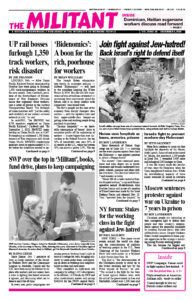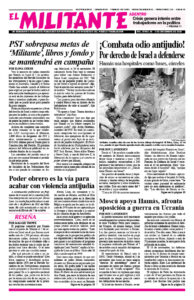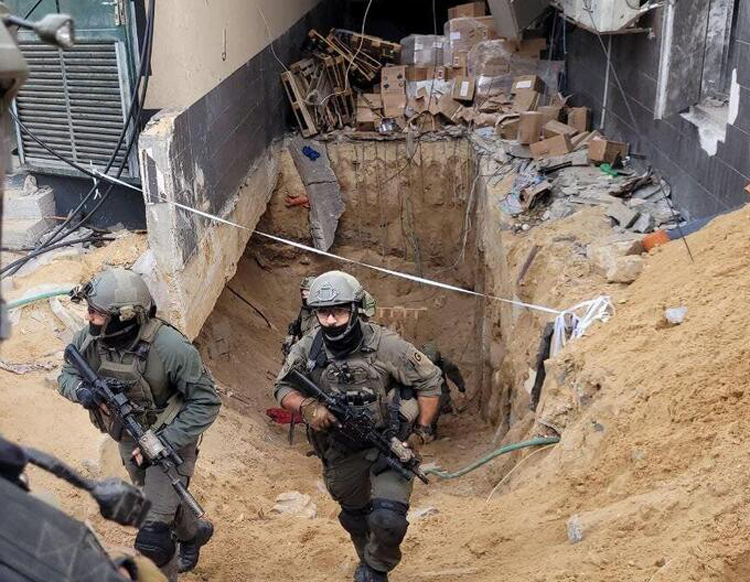More facts continue to come out that highlight the depravity of the Hamas death squads, financed and orchestrated by Tehran, that murdered 1,200 people in Israel Oct. 7, wounded 5,400 more and kidnapped 240 hostages to Gaza.
It was the largest single-day murder of Jews since the Holocaust, when the Nazis slaughtered 6 million Jews. While the overwhelming majority of those killed, wounded or seized in southern Israel Oct. 7 were Jewish, the terrorists also brutalized Arabs and immigrant farmworkers.
The slaughter marked a turning point in world politics and underscored the deadly reality of Jew-hating violence amid the decay of the world capitalist order.
Apologists for Hamas around the world claim that reports of the massacre are fake news or greatly exaggerated.
But anyone looking at eyewitness reports and the photos and videos of the pogrom — including body cam film from Hamas itself — knows those claims are a lie.
The notebook of one Hamas terrorist recovered at the Beeri kibbutz contained their orders: “Kill as many people and take as many hostages as possible.” That’s what they did.
The death squads surrounded the Supernova dance festival, attended by some 4,000 people. More than 360 were killed, 100 more than first estimated.
Hamas thugs targeted women
A video just released by FirstReponders shows Hamas gunmen catching up to two women who were running away. They grab one by the hair and shoot her. One gunman shoots the other woman repeatedly while she is lying on the ground.
Going door to door in farming towns, the terrorists rounded up whole families, tied their hands behind their backs and then shot mother, father and children in the head. Others were burned alive when the group tossed grenades into their homes.

Abuse of women was a special feature of the Oct. 7 assault, as it always has been with anti-Jewish pogroms, from Europe to the Middle East.
Hamas operatives gang-raped some women before murdering them. “Children through elderly women have been raped,” an Israel Defense Forces reservist who helped recover remains told the Times of Israel. “Forcible entry to the point that bones were broken.”
Despite Hamas’ pretense that it is defending Palestinians, its thugs also brutalized, killed or took hostage Bedouin, Palestinian and other Arab citizens and residents of Israel. A dashboard camera Oct. 7 recorded them viciously beating Osama Abu Asa, a Bedouin who watched over stores at Kibbutz Reim, 5 miles from the Gaza border. He was later found shot dead.
Members of Kibbutz Nir Oz were proud of being peace activists. Many opposed the politics of Prime Minister Benjamin Netanyahu. They often volunteered to give Gazan residents who had been approved for medical treatment in Israel rides to the hospital and back to the border.
That didn’t save them. The only thing that mattered to the death squads was that they were Jews or Jewish “collaborators.” Hamas thugs murdered or took hostage one-quarter of the Nir Oz’s 427 residents. Forty were murdered, including 11 Thai immigrant workers, and 79 kidnapped.
The Oct. 7 massacre could have been worse.
Hamas, which worked with Tehran and Hezbollah for over a year to plan the assault, caught the Israeli government by surprise with few troops in place near the border. Regardless of the lack of Israeli government preparation, the reason the slaughter happened was because Hamas exists and acts on its pledge to destroy Israel and kill Jews.
The death squads made it all the way to Ofakim, about 14 miles from Gaza. Israeli officials say these squads were prepared with several days of food and ammunition, hoping to make it all the way to the Palestinian West Bank, another 14 miles away, slaughtering more Jews along the way. One of Tehran’s goals is to turn the West Bank into another Hamas-run dictatorship.
The invasion was intended to force Israeli government forces to bomb Gaza and sacrifice Palestinian civilians’ lives so that Hamas could claim them as “martyrs” and provoke a wider war with Tehran and Hezbollah.
Outnumbered kibbutz community militias fought valiantly against the assassins. Some retired and off-duty soldiers, hearing about the attack, grabbed their weapons and headed to confront the thugs. This slowed them down, allowing the Israel Defense Forces to enter the fight.
Far from generating support, the pogrom has deepened opposition among Palestinians in Israel to the reactionary group. While the massacre was still going on, Bedouin Arabs along with Jewish Israelis risked their lives to save participants in the dance festival and on the kibbutzim.
Arabs in Israel reject Hamas
“Hamas terrorists did not harm only the Jewish citizens of the country, but all of us, Arabs and Jews,” Ranin Bolous, an Arabic language news anchor at Israel Channel i24, told the daily Israel Hayom Nov. 16. She is an Arab-Christian citizen of Israel
“Hamas expected and hoped that the Israeli Arabs would revolt from within,” she noted. In 2021 there were clashes and riots in mixed Jewish-Arab cities after Hamas fired rockets into Israel. This time that didn’t happen. “Even people who in the past presented Hamas as a resistance movement speak of them today as terrorists, as animals. Who does such things?”
Bolous says she tells fellow Palestinians that “there is no such thing as ‘Palestine from the river to the sea’ [Hamas’ call to eliminate all the Jews] and there will not be.”
The Israel Defense Forces have made steady advances in Gaza since launching the offensive to dismantle Hamas. Northern Gaza is largely under its control — at least above ground. Major Hamas centers are surrounded in the south. The pressure on Hamas has led to its offer to release some hostages in exchange for a pause in the fighting.
The Israeli government agreed to a deal Nov. 22. It will free 150 Palestinians held in Israeli jails; pause fighting for four days; and allow fuel deliveries to Gaza. In exchange Hamas will release 50 women and child hostages. A further 30 hostages could be released. Netanyahu says Israel will then resume its war on Hamas.
Debate in Israel
Like other capitalist countries around the world, there is debate in Israel over what is at stake with Hamas’ assault, along with attempts by the government to use the war to make inroads on democratic rights.
The Israeli government at first banned a small demonstration that planned to call for a cease-fire, but then relented after the Association for Civil Rights in Israel filed a lawsuit.
The Communist Party of Israel, part of a coalition of Arab parties that has seats in the Israeli parliament, backs a call for a ceasefire issued by 35 Jewish and Arab organizations. While the groups said they were “stunned and shocked” by the Hamas massacre, they called the Israeli government’s war on the group’s tunnels and bases in Gaza “additional atrocities.”
But Zazim, a group of Arab and Jewish Israelis that campaigns for “equality and joint civic engagement,” refuses to back cease-fire calls, even though they have done so during previous rounds of fighting with Hamas.
“As we learn more about the horrors of that day, the situation is different,” wrote Raluca Ganea, the group’s head, in a column in Haaretz. “Hamas isn’t a partner and we can’t simply stop firing.”


